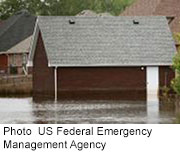
WEDNESDAY, Oct. 31 (HealthDay News) — The torrential rains and hurtling winds of “superstorm” Sandy are slowly passing through, along with some of the more acute health dangers such as falling trees and high flood waters.
But in the days, weeks and months to come, residents of the hardest hit areas will face myriad risks to their health, experts say.
Sandy, dubbed a post-tropical cyclone by the National Hurricane Center, swept through the U.S. Northeast on Monday and Tuesday, leaving entire towns under water and dozens dead.
Overall, an estimated 7.2 million people across the Northeast were without power Tuesday morning, including much of New York City.
First, experts say, there are short-term hazards. Residents struggling to return and re-establish themselves in the region can’t afford to forget that water plus electricity can add up to lethal danger.
“Don’t try to deal with electricity while any part of your body is touching water,” urged Dr. Pavani Ram, associate professor of social and preventive medicine at the University at Buffalo’s School of Public Health and Health Professions. “If you’re standing in water, you shouldn’t be trying to turn the electricity off or touch any kind of electrical appliance.”
Then there’s the risk of carbon monoxide poisoning from small generators, especially if the generators are placed in poorly ventilated areas such as a garage or basement, Ram added.
Longer-term dangers loom, as well. Ironically, all the water unleashed by Sandy could mean a shortage of clean drinking water. Residents need to be on the alert for water-related advisories from the health department or local water authority. Even in the absence of such alerts, they may want to stick to bottled or boiled water until they get more information.
People should also be careful about consuming perishable food, such as eggs or milk, that’s been languishing in a refrigerator without power. “People are not going to do themselves any favors by getting sick in the midst of the crisis,” Ram said.
Big storms can also boost concentrations of pollen and mold, two major allergy triggers, according to the American College of Allergy, Asthma and Immunology (ACAAI).
“Immunocompromised people and elderly people are probably at highest risk for complications from mold exposure and these are the people who should stay away from water-logged buildings, especially for prolonged periods of time,” Ram said.
Still, allergies and asthma were not among the main problems following Hurricanes Katrina (2005) and Isaac (2012), said Dr. Joseph Guarisco, chief of emergency services at Ochsner Health System in New Orleans, who lived through both of those disasters.
Instead, his department saw scores of injuries stemming from recovery and clean-up efforts. This included electrical injuries, hand injuries, soft tissue injuries from falls and slips, eye injuries.
“We were inundated with recovery and clean-up injury-related illness more than anything for quite some time after the storm,” Guarisco said. He advised that people wear protective gear during clean up and reconstruction and to stay away from power lines.
Elderly patients and those with chronic illnesses who depend on health care networks and on having medication suffered as well, Guarisco pointed out. “Those resources are disconnected [after a storm] and a lot of those patients have a tough time getting their basic needs met,” Guarisco said. “They didn’t take their medications. Their nutrition was bad and they became dehydrated.”
More information
There’s more about protecting yourself before and after major storms at the U.S. Centers for Disease Control and Prevention.

